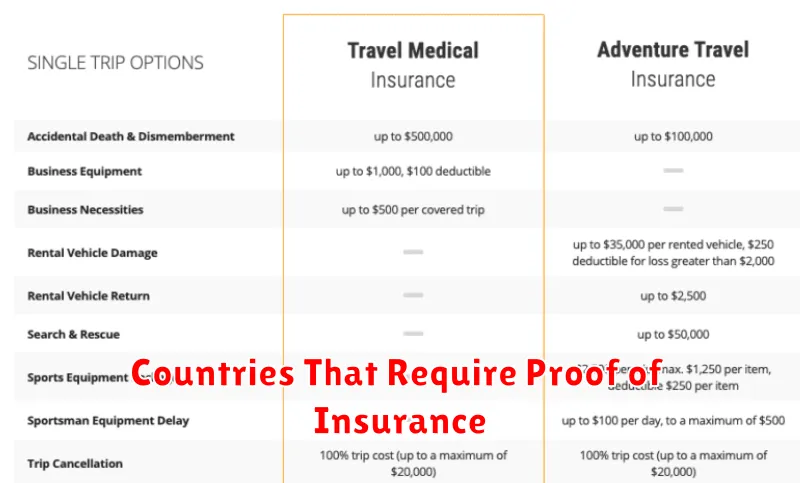Planning an adventure sports trip? From scaling sheer cliffs to navigating whitewater rapids, pushing your limits can be exhilarating. But it also comes with inherent risks. Understanding travel insurance specifically designed for adventure sports is crucial for protecting yourself financially and ensuring you have access to necessary resources in case of an accident or unforeseen event. This article explores the essential aspects of adventure sports travel insurance, highlighting why it’s a non-negotiable investment for any thrill-seeker.
Standard travel insurance policies often exclude or severely limit coverage for high-risk activities like adventure sports. That’s why specialized adventure sports travel insurance is so important. We’ll delve into the key coverage features you should look for, including emergency medical evacuation, search and rescue, trip cancellation and interruption due to weather or injury, and coverage for your sports equipment. Understanding these components will empower you to make informed decisions and select the best policy to suit your individual adventure travel needs.
Adventure Activities That Require Extra Coverage
Certain adventure activities come with inherent risks that standard insurance policies may not fully address. These activities often involve a higher probability of injury or require specialized rescue operations. It’s crucial to understand that participating in these activities may necessitate additional coverage options like specialized travel insurance or adventure sports insurance. Failing to secure adequate coverage could leave you vulnerable to significant financial burdens in the event of an accident or emergency.
Activities that typically require supplementary insurance include, but are not limited to: mountaineering, backcountry skiing or snowboarding, rock climbing, whitewater rafting/kayaking, scuba diving, skydiving, and base jumping. These activities often involve remote locations, challenging terrains, and unpredictable conditions, all of which increase the potential for accidents and injuries.
Before embarking on an adventure activity, carefully review your existing insurance policies to understand their limitations. Consult with an insurance provider specializing in adventure travel to discuss the specific risks associated with your chosen activity and secure the appropriate level of coverage. This proactive approach will ensure you are financially protected and can focus on enjoying your adventure with peace of mind.
Why Standard Travel Insurance May Not Be Enough
Standard travel insurance policies offer a baseline of protection, typically covering common issues like trip cancellations, lost luggage, and medical emergencies abroad. However, these policies often have limitations and exclusions that may leave you vulnerable in certain situations. For instance, pre-existing medical conditions might not be fully covered, or there might be caps on reimbursement amounts for specific incidents. Adventure activities like scuba diving or mountain climbing are frequently excluded from basic plans, requiring supplemental coverage. Therefore, it’s crucial to carefully review the policy details to understand its scope and identify potential gaps in coverage.
Beyond the limitations of standard coverage, your individual needs and travel style should dictate the level of protection you require. If you’re carrying expensive equipment like cameras or laptops, you might need additional coverage beyond the standard baggage allowance. High-value trips, like cruises or safaris, often warrant specialized insurance to protect your investment in case of unforeseen cancellations or interruptions. Furthermore, if you’re traveling to a remote or politically unstable region, consider a policy that includes emergency evacuation and repatriation coverage.
Choosing the right travel insurance involves more than just ticking a box. It requires thorough research and a realistic assessment of potential risks. Consider factors such as your destination, the activities you’ll be participating in, and your personal health conditions. Comparing different policies and speaking with a travel insurance professional can help you identify the right coverage for your specific needs, ensuring you have adequate protection and peace of mind throughout your journey.
Popular Providers for Adventure Policies
Finding the right insurance for adventurous activities can be crucial. World Nomads is a popular choice, known for its comprehensive coverage for a wide range of activities, from trekking and scuba diving to more extreme pursuits. They offer flexible plans and are geared towards long-term travelers and digital nomads. Another strong contender is Allianz Travel Insurance, which provides various packages catering to different adventure levels. Be sure to carefully review policy details to ensure it aligns with your specific needs and planned activities.
IMG Global is another provider to consider, offering adventure sports add-ons to their standard travel insurance policies. This allows for customization and potentially lower costs if you only need coverage for specific activities. When comparing providers, pay close attention to the fine print. Understand what is covered and, more importantly, what is excluded. Certain high-risk activities might require supplemental insurance or specific waivers.
Before embarking on your adventure, confirm your chosen policy covers emergency medical evacuation, as this can be a significant expense in remote locations. Also, consider coverage for lost or damaged equipment, trip interruption, and personal liability. It’s essential to choose a provider with a solid reputation for customer service and reliable claims processing, especially when dealing with unexpected situations abroad.
Reading the Fine Print

Contracts, agreements, and legal documents often contain crucial details in the fine print. Carefully reviewing this information is paramount to avoid misunderstandings and potential negative consequences. Ignoring the fine print can lead to unexpected fees, unwanted obligations, or limitations on your rights. Take the time to thoroughly examine all clauses, even those that appear insignificant.
Key elements to look for include payment terms, renewal policies, termination clauses, and any disclaimers or limitations of liability. If any part of the fine print is unclear or confusing, seek clarification. Don’t hesitate to ask questions or consult with a legal professional before signing anything. Understanding the full terms and conditions is essential for making informed decisions.
Protecting yourself requires diligence. By paying close attention to the fine print, you can avoid pitfalls and ensure you’re fully aware of the implications of any agreement. This proactive approach can save you time, money, and potential legal headaches in the long run.
Filing a Claim After a Sports Injury
Experiencing a sports injury can be frustrating and painful, especially if someone else’s negligence caused it. If you’ve been injured due to another party’s fault, like a reckless opponent or unsafe playing conditions, you might be entitled to file a claim. It’s crucial to gather evidence immediately following the incident. This includes taking photos of the scene, getting contact information from witnesses, and documenting your injuries with a medical professional. A detailed record of the incident and the resulting harm is essential for a successful claim.
The specific claim process varies depending on the context of the injury. If the incident occurred during an organized sporting event, there may be specific rules or procedures outlined by the league or governing body. For instance, a school or recreational league might have established protocols for handling injury claims. Alternatively, if the injury stemmed from negligence on public property or during an informal game, you might need to pursue a personal injury claim through the responsible party’s insurance. Consulting with a personal injury lawyer is strongly recommended to determine the best course of action and understand your legal rights.
Time is of the essence when filing a sports injury claim. Statutes of limitations restrict the timeframe within which you can legally pursue compensation. These deadlines vary by jurisdiction and the nature of the claim, so prompt action is critical. A lawyer can advise you on the applicable deadlines and help you navigate the often complex legal landscape surrounding sports injury claims. Don’t delay seeking legal counsel, as failing to meet these deadlines could prevent you from recovering damages for your injuries.
Countries That Require Proof of Insurance

Many countries require proof of insurance for visiting drivers. This is often referred to as “Green Card” insurance, though the document itself isn’t always green. It’s a confirmation that you have the minimum required liability coverage should you be involved in an accident. Driving without this proof can result in hefty fines, legal trouble, and even having your vehicle confiscated.
Countries where insurance proof is either mandatory or strongly recommended include most of Europe (Albania, Andorra, Austria, Belarus, Belgium, Bosnia and Herzegovina, Bulgaria, Croatia, Czech Republic, Estonia, France, Germany, Greece, Hungary, Iceland, Ireland, Italy, Kosovo, Latvia, Liechtenstein, Lithuania, Luxembourg, Macedonia, Malta, Moldova, Montenegro, Netherlands, Norway, Poland, Portugal, Romania, Russia, Serbia, Slovakia, Slovenia, Spain, Sweden, Switzerland, Turkey, Ukraine, United Kingdom), parts of Asia (e.g., Iran), and parts of Africa (e.g., Morocco, Tunisia). It’s advisable to check specific requirements for the countries you plan to visit as rules can vary and change.
Always contact your insurance provider before your trip to obtain the necessary documentation. They can advise you on the specific requirements and provide you with the correct paperwork. Be sure to keep the proof of insurance readily available while driving abroad.
Planning Smart for Risky Activities
Engaging in risky activities, whether it’s rock climbing, scuba diving, or even driving a car, requires careful planning to mitigate potential dangers. Assessing the risks involved is the crucial first step. This involves identifying potential hazards, understanding the likelihood of those hazards occurring, and evaluating the potential severity of the consequences. Considering your own skill level and experience is also vital. Overestimating your capabilities can lead to dangerous situations. Finally, developing a contingency plan is essential for addressing unforeseen circumstances and emergencies.
Proper preparation significantly reduces risk. This may include obtaining necessary certifications or training, acquiring and checking appropriate equipment, and familiarizing yourself with the environment or conditions you’ll be facing. For example, checking weather reports before a hike or ensuring your scuba gear is functioning correctly are critical preparatory steps. Don’t overlook the importance of sharing your plans with someone who isn’t participating, including your expected route, timeline, and emergency contacts. This allows for a faster response in case of an emergency.
Even with meticulous planning and preparation, things can still go wrong. Staying alert and adaptable throughout the activity is key. Continuously monitor the environment for changing conditions, assess your own physical and mental state, and be prepared to adjust your plans as needed. Don’t hesitate to abort the activity if conditions become unsafe or if you feel uncomfortable. Prioritizing safety is always the most important decision.

